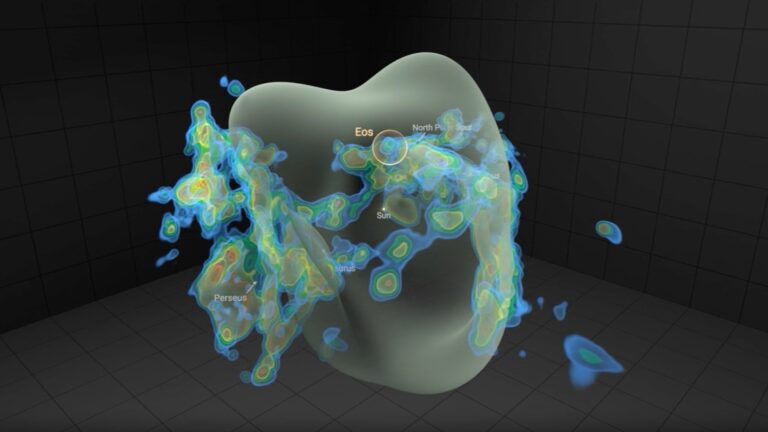
Webb Spots Surprising Signal From Galaxy Formed 330 Million Years After Big Bang – The Daily Galaxy
2025-04-22T14:00:00Z
A distant galaxy spotted by Webb is shining with a signal that shouldn’t exist — rewriting what we thought we knew about the early Universe.
Astronomers have uncovered a discovery that could reshape our understanding of the early Universe. Using the James Webb Space Telescope (JWST), researchers have observed a distant galaxy, JADES-GS-z13-1, emitting a strong Lyman-α signal — a form of hydrogen light — from just 330 million years after the Big Bang.
At that time, the Universe was thought to be shrouded in neutral hydrogen gas, which should have blocked such emissions. Yet this clear signal has challenged long-held theories about the epoch of reionization, the period when the first stars and galaxies began to illuminate and ionize the cosmos.
The finding, published in Nature, suggests reionization may have started earlier or occurred in more complex patterns than previously believed.
A Glow That Shouldn’t Exist
The galaxy was first spotted through deep imaging taken by Webb’s Near-Infrared Camera (NIRCam) as part of the JWST Advanced Deep Extragalactic Survey (JADES). Its extraordinary distance was confirmed using the Near-Infrared Spectrograph (NIRSpec), which revealed a redshift of z = 13.0 — meaning the light from this galaxy has been traveling for more than 13.4 billion years.
But it was the galaxy’s spectral fingerprint that astonished scientists. A distinct and powerful Lyman-α emission line — the signature of excited hydrogen — was clearly visible. This type of emission is usually suppressed at such early epochs, due to the thick veil of neutral hydrogen gas that filled the young Universe.
“The early Universe was bathed in a thick fog of neutral hydrogen,” explained Roberto Maiolino, a team member from the University of Cambridge and University College London. “Most of this haze was lifted in a process called reionization, which was completed about one billion years after the Big Bang. GS-z13-1 is seen when the Universe was only 330 million years old, yet it shows a surprisingly clear, telltale signature of Lyman-α emission that can only be seen once the surrounding fog has fully lifted. This result was totally unexpected by theories of early galaxy formation and has caught astronomers by surprise.”
The results were published in the journal Nature, and they raise fundamental questions about the timing and structure of the reionization period. The data suggest that pockets of ionized hydrogen may have formed much earlier than previously thought — or that reionization occurred unevenly, with certain galaxies clearing their own local regions of fog.
NASA’s James Webb Space Telescope has detected unexpected light from a distant galaxy. The galaxy JADES-GS-z13-1, observed just 330 million years after the big bang (corresponding to a redshift of z=13.05), shows bright emission from hydrogen known as Lyman-alpha emission.
A Light Breaking Through the Fog
The clarity and strength of the Lyman-α line were unexpected not just because of the galaxy’s age, but because it indicates that photons were able to escape and travel across space without being scattered or absorbed. This implies that the galaxy may have created a large ionized bubble around itself — a zone where the surrounding hydrogen had already been stripped of its electrons by intense radiation.
“We really shouldn’t have found a galaxy like this, given our understanding of the way the Universe has evolved,” said Kevin Hainline of the University of Arizona. “We could think of the early Universe as shrouded with a thick fog that would make it exceedingly difficult to find even powerful lighthouses peeking through, yet here we see the beam of light from this galaxy piercing the veil. This fascinating emission line has huge ramifications for how and when the Universe reionized.”
The source of this intense radiation remains under investigation. It could be the result of Population III stars — a theoretical first generation of massive, metal-free stars — or perhaps even an early active galactic nucleus (AGN) powered by a growing black hole.
A New Frontier in Cosmology
The implications of this discovery are far-reaching. If galaxies like JADES-GS-z13-1 were able to ionize their surroundings so early, the onset of the reionization era may have begun much sooner than current models suggest. It also adds weight to the idea that reionization was not a uniform process but rather occurred in isolated bubbles, each created by intensely luminous sources scattered throughout the early cosmos.
With its unmatched infrared sensitivity, the James Webb Space Telescope has opened an unprecedented window into the first few hundred million years of the Universe. What was once theoretical is now being confirmed in stunning detail — and sometimes, as in this case, completely upended. As follow-up studies continue, astronomers hope to uncover whether this galaxy is an outlier or just the first of many “impossible” discoveries waiting to be revealed.
Auto-posted from news source






